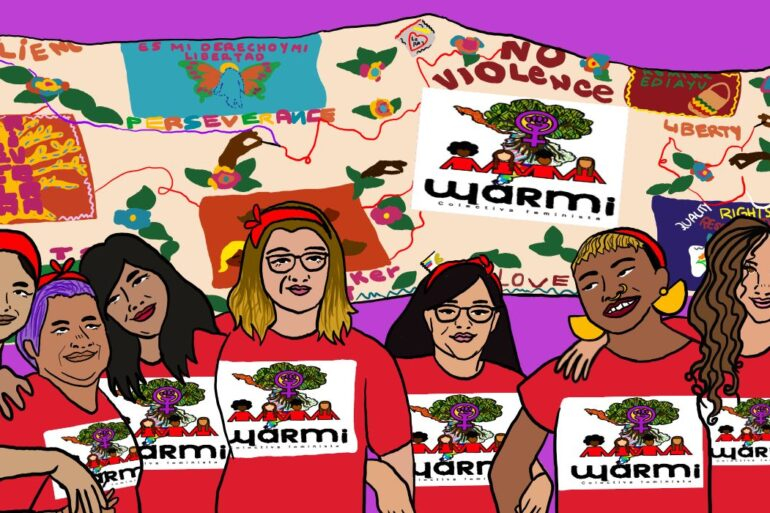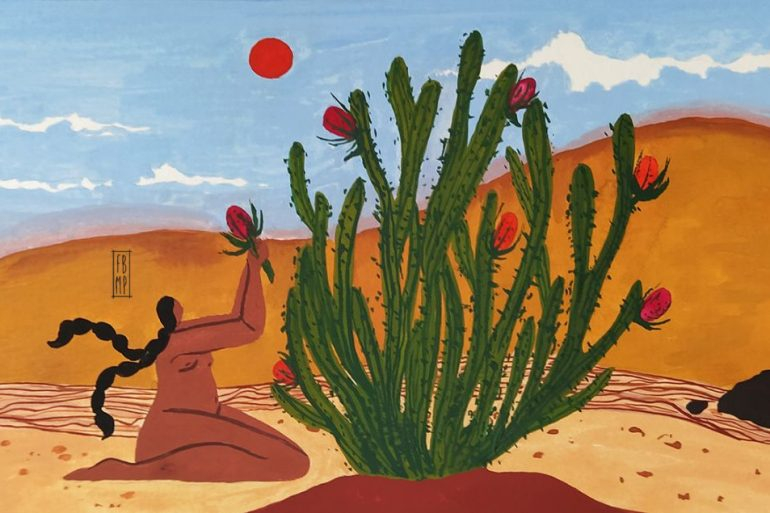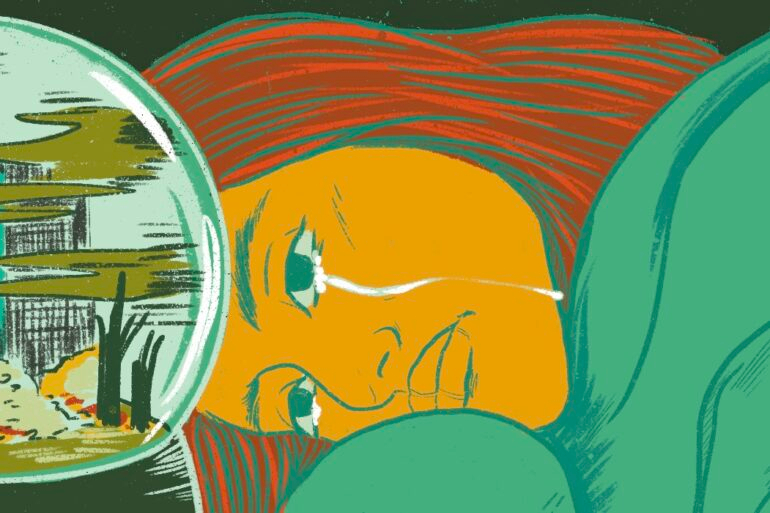WaterBear, a free streaming platform dedicated to the future of our planet, has launched its newest original content series, ReDress the Future, to explore some of the fashion industry’s most damaging factors and tangible solutions ahead of the infamous ‘month of fashion’.
Premiered on the platform on 10th September and hosted by anti-racism and climate justice activist Mikaela Loach, the three-part series explores the ideas and innovators subverting the status quo which underlies an unsustainable fashion industry. We speak to Mikaela Loach about the WaterBear series and her perspective on sustainability and the fashion industry.
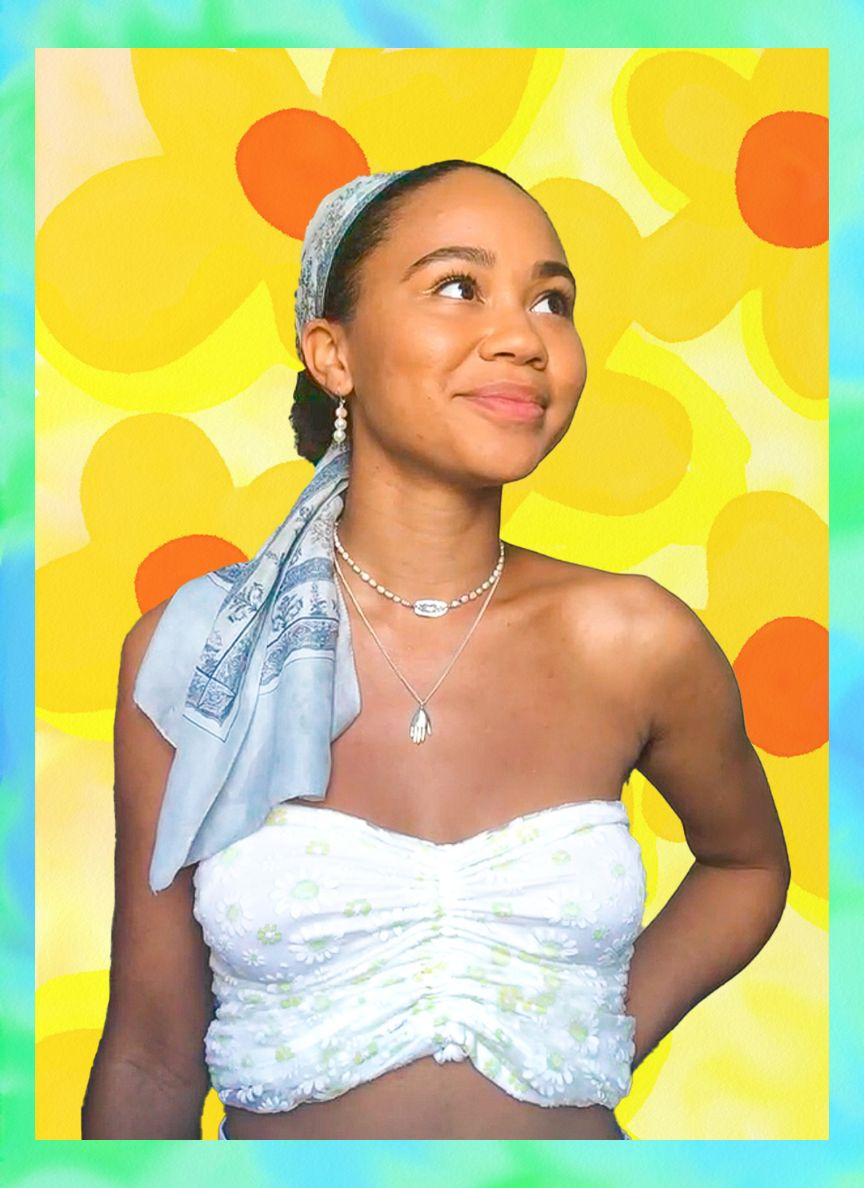
Who is the series targeted at? While lots of activists in the space (including yourself!) have been talking about these issues for years, do you think there is currently a knowledge gap in information and the way this knowledge is being disseminated?
The aim of WaterBear’s Original ReDress The Future series is an entry point for those who want to find out more about sustainable fashion. So, that includes people who may be interested in changing their shopping habits or how they decide to dress themselves, but maybe don’t know much about the alternatives that are out there. It’s also for people who might get a bit overwhelmed at the enormity of the problem but could be inspired by solutions.
Solutions are at the heart of the three-part ReDress The Future series. And most importantly, it’s also joyful and fun – we speak to really exciting designers like Phoebe English, Christopher Raeburn and Orsola De Castro. So I think if people are in any way hopeful about seeking solutions but also really into their clothes and fashion, they’ll love the series.
I’d definitely agree that there is a gap in information and more crucially in the way that knowledge has been disseminated. So, I think it’s good to have multiple ways of communicating around subjects such as sustainable fashion, solutions and circular economy. In this WaterBear Original series we took a creative approach to how we talked about the topic, so we could reach a range of people rather than focusing solely on facts and statistics.
Why do you think this knowledge gap exists?
I think the knowledge gap exists because it helps brands – they actually want it to exist. And they want this to exist because if people don’t know what’s going on behind the scenes it allows brands to continue doing harm unchecked. So, it’s a deliberate strategy enacted by these harmful brands to hide what’s really going on and also to hide the fact that solutions are out there and available if we choose people and planet over profit.
Do activists have a role to go directly to communities outside their immediate network or are we removing accountability from brands themselves to do this work?
I definitely think that all of us have the responsibility. I hope the ReDress The Future series teaches us that we need to not only go to communities outside of our immediate network but also to reach out to people who are in our own communities as well – to talk to our friends about these things, to challenge the people directly around us – but also to go out of these echo chambers and talk to people who have different perspectives. That’s why I think there can’t be enough different ways of communicating about this issue.
I don’t think we’re removing accountability from brands to do this work at all. I think that what we’re doing through this outreach is actually putting more pressure on brands to do what’s right. I think if we stay within our echo chamber; if we stay within the groups of people who already care and already know about these issues, then brands will still win in causing harm. We need to make it so that as many people as possible are asking these questions. We need to collectively challenge brands and change our habits if we’re actually going to create the future that we want, and to put enough pressure on brands to ensure that this future gets created. So, I think this is actually a really important way that we can call for accountability rather than allowing brands to avoid it.

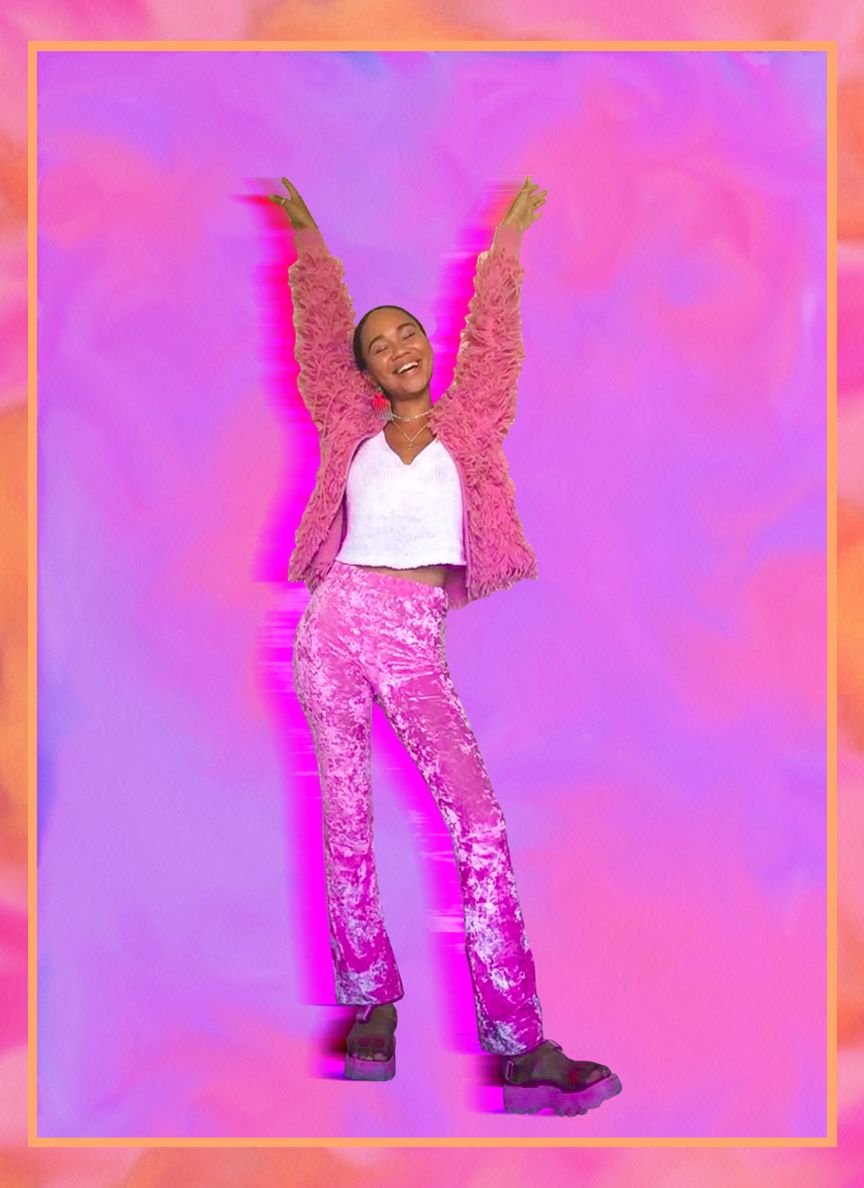
[Pink outfit details: Flares – secondhand from vinted. Jacket – secondhand – the jacket Mikaela gets given by her friend Rosie in Episode 1 of ReDress the Future when they pulled it out of her closet. Shoes – depop. Top – oest ]
What are some of the current limitations of sustainable fashion and how do you think some of these limitations can be improved?
Although there are really exciting solutions there are still definitely limitations to sustainable fashion, especially around access. This is something we talked a lot about in Episode 2 of the ReDress The Future.
A lot of these new sustainable brands, because of their price points and sizing, aren’t actually accessible to the majority of people. I think what’s needed is more of a paradigm shift in how we view clothing and how we view the clothes we already own. It shouldn’t be about acquiring more, it should be about using what’s there. That’s the main message of the WaterBear Original series; using what you have is the best thing that you can do.
I think one way that we can tackle some of the limitations, especially around accessibility, is to have better education about clothes. We need to learn more about where they come from, who made them and how to look after them. But also (and this is something that Orsola De Castro talks a lot about in the series), brands should have repair stations in their stores – there should be a responsibility from brands over the clothes once they are purchased. This responsibility shouldn’t just disappear as soon as the garment leaves the store.
“The fashion industry has designed itself to be opaque and exploitative”, says one of ReDress The Future’s interviewees from Stitch Don’t Ditch. What does this mean to you?
We talk a lot about broken systems and this sort of implies that the harm and exploitation is there by accident – like things have ‘gone wrong’. But when it comes to the fashion industry, the harm is very much deliberate. It is completely acceptable to these brands and to the industry as a whole and it has been built this way on purpose.
ReDress The Future shows that there are so many solutions which exist, and which are possible, but aren’t being used by wider brands. We need to remember that the industry has deliberately made itself opaque and exploitative so that they have as high profit margins as possible; that there is this ‘race to the bottom’ where corners get cut – and these corners are people’s livelihoods, lives and the planet.
Because the system has been designed this way, maybe reform can’t go far enough and we should consider other options such as abolition. That’s something that I’m definitely pondering on a lot more. This series gave me a lot of hope but it also gave me a lot more to think about – which I think is good, and what we should all be doing.
Subscribe to shado's weekly newsletter
Exclusive event news, job and creative opportunities, first access to tickets and – just in case you missed them – our picks of the week, from inside shado and out.

A common argument that comes up against the movement is the idea that fast fashion, by being cheap, is the only option for people in low socioeconomic circumstances. How do we reframe this?
This is a really important question and something that Aja Barber talks a lot about in her work. It’s a vital conversation. We need to acknowledge the fact that it isn’t people who are living on the poverty line who are propping up the fast fashion industry. They’re not the ones who have made fast fashion a multi-billion dollar industry. It is actually people who have privilege and could be choosing different options, who are propping up the fashion industry. It is to do with people buying too much and over consuming.
Something that we talk a lot about in the series is how we need to decrease consumption. We need to slow everything down rather than continuing the model as it is now. So, I think there is so much that needs to be done on a structural level to tackle why we even live in a world where for some people there is no other choice but to buy clothes that have caused harm to other people. I think we need to interrogate capitalism and interrogate the exploitative systems that we live under and tackle that wholeheartedly.
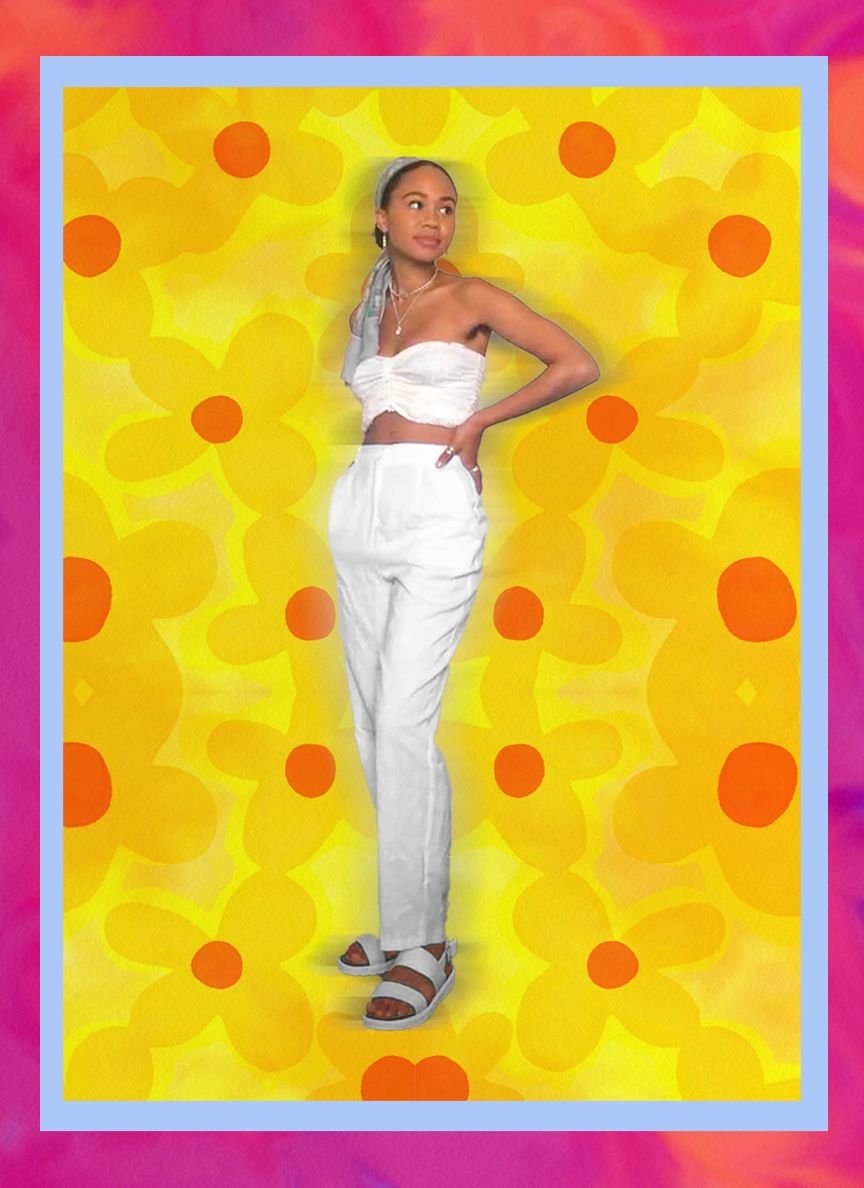

[White outfit details: Headscarf – vintage store on brick lane – 5/6 years ago. Top – depop. Trousers – vintage thrift store in glasgow. Shoes – Matt and Nat ]
We love the distinction made between opportunity and obligation in episode one of ReDress The Future – can you go a bit more into this? If the rhetoric shames the consumer rather than the brand, some argue that it fails to consider issues of privilege, class, size etc. Can you talk a bit more about the movement and its focus on brand accountability and obligation?
I’m so glad that you’ve touched on things that Orsola De Castro spoke about in the documentary here, because we had so many more conversations that didn’t make it into the final edit. She is brilliant, and that distinction between opportunity and obligation is so important because so often the rhetoric can shame citizens rather than the brands who have way more agency and ability to create change.
When we put all of the onus on the individual and on citizens rather than the brands, we’re telling a story that isn’t correct. Because we’re assuming that everyone has the same amount of agency to make a difference when that’s just not the case. We live in a world where people are oppressed and live under systems of exploitation and oppression for different reasons. And things aren’t accessible for everyone in the same way – due to factors like size, like class. So, it’s important that whilst I do think we have a responsibility to each other as citizens in this world, we don’t all have the same amount of agency in creating change. The reality is that brands, governments and big institutions have an obligation to be responsible for the harm that they are actually creating and designing. When we individualise everything I think we can let a lot of these big corporations and brands off the hook.
I think that we shouldn’t accept things as normal just because they are the way they are. I watched a talk by Angela Davis last night, where she says “you must not attribute any permanency to that which is simply because it is”, and that really resonated. I think we are guilty of attributing permanency to the amount of harm that is caused in the fashion industry because we just say that’s how it’s always been. But it doesn’t have to be this way, and I saw this so crucially in this series. The industry has deliberately chosen this model, and therefore it is now their obligation to choose better and to choose a world where all of us are respected and safe. That should be the bare minimum.
Fashion Revolution have argued that ‘sustainability is no longer a fringe issue but the most defining challenge and opportunity of our time’. What are some of the biggest opportunities you see?
Absolutely, I think that one of the biggest opportunities that I can see from sustainability is that climate solutions make a better world for all of us. We are not separate from the planet, we are not separate from nature – as much as capitalism tries to tell us that we are. We are so inherently connected to it and actually the things that are more sustainable make a better and a safer world for all of us. The fashion industry also has huge health impacts as well as climate impacts. So when we decrease things that are harmful to the planet we can increase wellbeing and increase health and happiness. We have an opportunity here through sustainability to create a more just and liberated world for all of us.
What are your hopes for the series? There are clear actionable steps in the episodes, so is action one of your biggest hopes?
Waterbear specifically want to make their series’ and the documentaries really actionable – so that people can watch in order to learn what they can do. As much as inspiration is helpful, they want people to receive active hope from it and that’s what I think we’re trying to get across. For example, ReDress The Future encourages viewers to take action and connect with fashion NGOs including Fashion for Good, FashionTakes Action, Fashion Revolution, and Changing Markets.
I would love to see more people get involved in organising around garment workers’ rights, around sustainable fashion and being part of the organising parts of it. Movements like Stitch it Don’t Ditch it and Gentle Nuisance, being part of Fashion Revolution, or getting involved in the Who Made My Clothes campaign. There are loads of actionable steps – even just by changing how you bring things into your life. At the core though I hope to get across to viewers that we hold a connection to the things we wear on our body, We have a connection to all the people in the world and we must respect and honour everyone. Hope is an active stance – it isn’t passive. And I feel that for me this series showed me that and it was exciting to be a part of this.
What power do you think films/docu-series can have in enacting change and why did you choose to pursue this format?
In my life, films and documentaries have had a huge impact on me. I think of all the documentaries which have completely transformed my life. It was watching the True Cost documentary on WaterBear’s platform which made me stop buying fast fashion in the first place and it really inspired me to get involved in writing about and working around this. I watched it about seven years ago, so it felt really surreal to be making a WaterBear documentary where I was interviewing Orsola de Castro, who was one of the people in True Cost. As I tell her in the series, it was her words about our clothes being our chosen skin that completely changed my life.
I think that finding different ways to communicate about issues is really important. For me, film provides a format that is perhaps more accessible to people than written things and it was an absolute dream presenting this.
The global apparel and textile industries account for more CO2 emissions than international flights and maritime shipping combined. However, it also accounts for widespread human exploitation, economic degradation and modern slavery, of which women in the so-called Global South are disproportionately affected. For years the focus of the climate movement has solely been on reducing “carbon footprints” – why is it so important for us to shift this narrative to the wider systems in place and more of a human rights framework to understand how people and planet are interconnected in these supply chains?
I’m so glad that you’ve asked this question, because what is so important here and for all the work we do for sustainability and liberation, is that we don’t individualise all of these problems that are in fact problems with systems.
When we individualise these things and make it about a carbon footprint we are telling a story that isn’t correct. The term carbon footprint was actually popularised by fossil fuel company BP, which says a lot about big corporations shifting the narrative and the blame. Why would a fossil fuel company want to popularise the idea of a carbon footprint? It’s because it takes the responsibility and the onus for the harm that is being caused away from them and onto individuals, and it assumes the same amount of agency between these two entities.
I think it’s really important for us to realise that the harm that is caused in the fast fashion industry is inherently connected to capitalism, through exploitation and this ‘race to the bottom’ which keeps wages as low as possible in order to keep profit margins as high as possible. It’s connected to climate injustices, it’s connected to feminist struggles, it’s connected to so many different things and all of these struggles are interconnected. As Audre Lorde says, “we don’t have single issue struggles because we don’t lead single issue lives”.
I think it’s really important for us to zoom out sometimes and realise it’s a systems issue that’s causing all of this and that we can’t actually have real solutions or a better world if we don’t tackle these systems. We need to be aware that a lot of the things that are exploitative of the land and planet are also exploitative of human beings too and all of these systems are completely connected and to disconnect them is a disservice.

Watch the WaterBear Original ReDress the Future three-part series on WaterBear.com. Peep the trailer below!
https://www.instagram.com/p/CToiuniq9hi/
| While watching the series, viewers can connect with sustainable fashion NGOs including Fashion for Good, FashionTakes Action, Fashion Revolution, and Changing Markets, and take action. Top tips on how to build a more sustainable fashion future include;
– Check out second-hand stores or use apps like Vinted and Depop – Stick it don’t ditch it – try repairs yourself or find someone who’s nifty with a needle – Support sustainable brands that use materials that don’t cost the Earth – Transform old into new with quick and easy upcycling methods – Support companies championing circular fashion model – Try to buy less, and buy better For more tips, download WaterBear from the app store or head to: https://waterbear.com |









